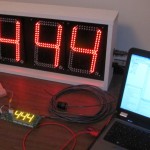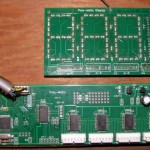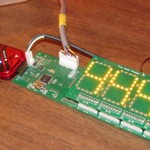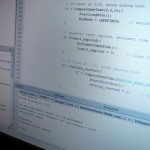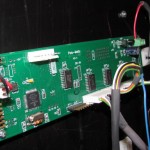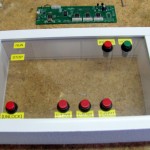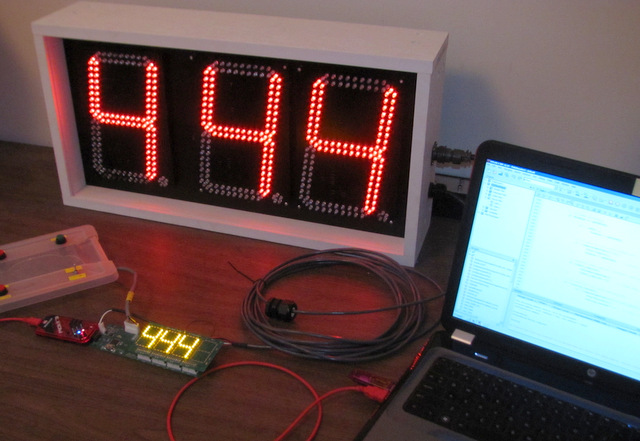
Polo Timer Prototype
By admin, December 6, 2014
Custom polo timer designed, prototyped, and programmed to enhance the match
After attending a couple fun polo matches with a small local club, I decided to build and donate a polo match timer for their field.
I based the project on the Microchip PIC24H microprocessor. This 16 bit processor contains an amazing variety of I/O plus Flash memory and RAM on a chip the size of a fingernail, and sells for just a few bucks. While there are many more powerful microcontrollers out there, it’s an excellent choice for lots of features when sheer processing power is not needed.
Instead of just making prototype breadboards, I decided to design printed circuit boards (PCBs) to make things neat and reliable. I decided the timer would use two identical PCBs, a Master in the user-interface panel and a Remote in the outdoor display unit.
The main board holds the highly-integrated processor and high-current, open-drain, protected drivers for controlling large LED displays. Communications between the boards is by serial RS485, which can be used at distances in excess of 1km. I might use the PCB for other experiments, so I put on a second RS485 channel, an extra LED driver chip, a small prototyping area, and a voltage reference and test points to use the A/D and D/A of the processor. I ended up with only one small jumper needed on the logic board; not too bad!
Microchip offers a variety of inexpensive PIC24H development tools including a free C compiler and Integrated Development Environment (IDE) which works quite well (and now supports Linux!). I used the IDE to write code in C for the Master and Remote boards, and the PICKIT 3 interface to program them and perform source level debugging. In short order I had the prototype up and running!
Having a full symbolic programming environment, with source level debugging, breakpoints, and single stepping, basically for free, is rather mind boggling. A few years ago those were things I only dreamed of having while working for wealthy corporations!
On the back of the outdoor display unit, the Remote board drives large LED digits. I tried to make the outdoor unit quite rugged and relatively weather-proof. The outdoor unit holds the power supplies (and car horns for announcing end of period). Only one cable to the control panel is needed.
My original user interface panel had an off-the-shelf 2″ red LED display (with serial interface), but we just couldn’t reliably see it in direct sunlight. So I designed my own display PCB using tiny high-brightness amber LEDs driven by the logic board’s driver chips. It stacks right on top of the logic board to eliminate cabling and is way brighter.
This winter I hope to change the outdoor unit LED digits to high-brightness green LEDs. We found the red just didn’t have great visibility in the glare of a sunny polo field. I asked the vendor about making the displays with brighter LEDs (they are made in Thailand!), but they weren’t interested, so I will have to change them myself. It’s going to take a lot of desoldering, but I think it will be worth it. I also have a rugged “plastic lumber” enclosure in the works for the user interface.
Hopefully the unit will be ready for matches in the spring of 2015!
Tags
Archives
- July 2023
- January 2023
- December 2022
- October 2022
- September 2022
- August 2022
- July 2022
- August 2020
- April 2018
- September 2017
- July 2017
- January 2017
- December 2016
- September 2016
- January 2016
- October 2015
- August 2015
- July 2015
- April 2015
- March 2015
- January 2015
- December 2014
- July 2014
- May 2013
- June 2012
- May 2012
- November 2011
- March 2011
- December 2010
- February 2010
- August 2009
- June 2009
- December 2007
- June 2007
- September 2006
- April 2006
- May 2005
- December 2002
- June 2002
- December 2001
- August 2001
- June 2001
- November 2000
- December 1998
- October 1998
- December 1997
- October 1996
- April 1995
- April 1994
- December 1993
